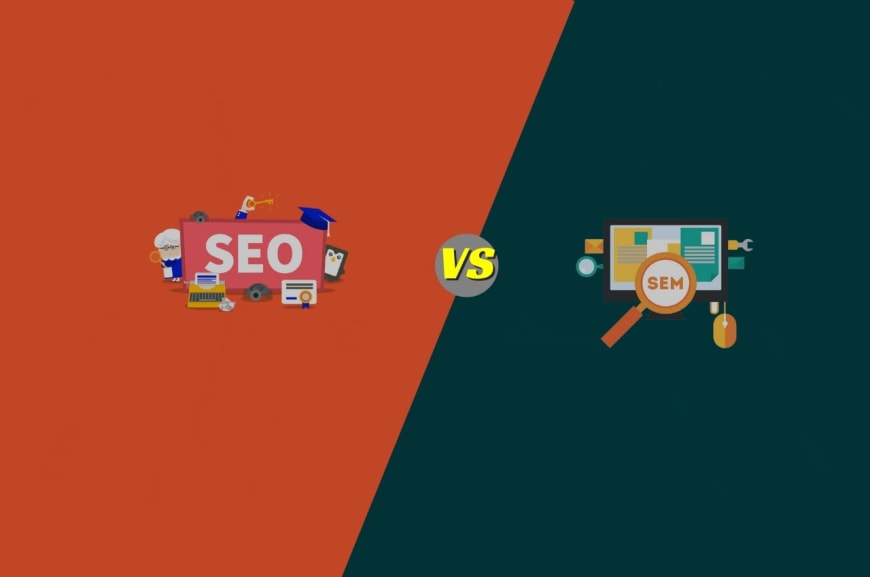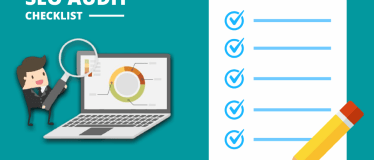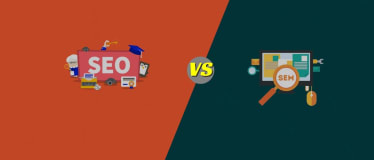Acronyms tossed about in the marketing world can be confusing to newcomers dipping their toes into digital marketing for the first time. Search engine marketing (SEM) and search engine optimisation (SEO) sound like different names for the same thing and can often lead to some confusion. However, the difference one letter can make is significant when it comes to digital marketing strategies.
What are the Main Differences Between SEO SEM Digital Marketing?
SEO was once considered a subsection of SEM that focuses on achieving higher positions in the search results to take advantage of free organic traffic. The concept of free is relative because it takes time, effort, and money to achieve page one search rankings.
The higher your page ranks, the more traffic you have to your site. Once you accomplish a page one ranking, SEO will continue to generate traffic. Further investment in SEO is not needed, or at least, can be significantly reduced while the site continues to rank highly.
Most digital marketers now consider SEM as dealing exclusively with paid search. Search Engine Land describes Search Engine Marketing [*1 https://searchengineland.com/guide/what-is-paid-search] as "the process of gaining website traffic by purchasing ads on search engines."
In summing up, SEM is a paid search strategy, while SEO digital marketing is an organic search strategy. Both must find a place in your digital marketing strategy.
Components of an SEO Digital Marketing Strategy
Search engine optimisation encompasses a wide range of activities to accomplish results and has three main areas of operation: off-page SEO, on-page SEO, and technical SEO.
On-page SEO refers to activities you perform directly on a website, such as:
* Creating content to match search intent
* Creating in-depth quality articles to provide solutions to search queries
* Formatting URLs with keywords
* Adding relevant metadata (title tags and meta descriptions)
* Creating descriptive alt tags for images
* Using keywords in blog articles and web copy
Technical SEO covers the technical aspects of a website to assist search engines in crawling your site and accurately indexing your content to improve search engine rankings. Examples of technical SEO include:
* Improving page load speeds
* Preventing duplicate content penalties with canonical tags
* Optimising the robots.txt file to improve crawl efficiency
Off-page SEO includes activities you do elsewhere on the web away from the site and includes:
* Acquiring backlinks
* Guest posting
* Promoting your site on social profiles
* Using social bookmarking sites like StumbleUpon, Digg, and Reddit to increase traffic
* Optimising your Google My Business Listing (Important for local SEO)
* Provide exceptional service to attract positive reviews
While it would be nice to achieve a page one ranking and have it stay there in perpetuity, it is rarely as convenient as that. Continuously evolving search engine algorithms and the continuing SEO strategies of your competitors will eventually undermine your SEO efforts. Regular monitoring, maintenance, and updates are required to keep your site relevant and in line with the latest algorithm updates.
What are the Advantages of SEO?
Optimising your site for the search engines creates many advantages for an organisation.
Visitors who arrive at your site via a search are usually further along the sales pipeline than someone who may have clicked on an ad out of curiosity. Searchers are actively engaged in researching for information, finding a solution to a problem, or looking for the best deals on a specific product.
SEO can be cheaper than SEM strategies because you aren't always paying for ads. A more significant cost advantage is that even if you stop working on SEO, your site will continue to rank for some time before dropping off the front page. If you have put in a solid SEO foundation, it can take years before your site loses its ability to rank for a given keyword. Regular updates to content will usually prevent this from happening.
People trust Google's opinion, so any site that appears high in the search results will automatically gain some level of implied trust and authority, which helps to strengthen your brand.
Components of Search Engine Marketing (SEM)
SEM is conducted exclusively through paid advertisements on search engines like Bing, Google, and YouTube. Ads are available in a variety of different formats, including pay-per-click, or cost-per-view (CPV). There are also other strategies you can use depending on your needs, such as display advertising, shopping/product advertising, and remarketing.
Pay-Per-Click Advertising — Pay-Per-Click advertising are ads that only attract a fee when search engine users click on a link in the advertisement. Just about every search will include paid ads appearing beside or above the organic search results.
Cost-Per-View — You pay for the ad if a viewer on a video site such as YouTube watches your advertisement for a predetermined number of seconds. On YouTube, a view is 30 seconds, or less if your ad runs shorter than that. Facebook implements a 15-second timeframe for their video ad campaigns. You will also pay if a user interacts with the ad in some way, such as clicking through to your site.
Do SEO Digital Marketing and SEM Have Anything in Common?
At first glance, SEO digital marketing and SEM seem to be two completely different marketing systems. For the most part, this is true, but both rely on the efficient use of keywords to get the best results. Keywords are the foundation of both SEO digital marketing and SEM campaigns. If you are targeting the wrong ones, then either strategy will fall flat.
How To Generate Revenue With SEM
Paid ads on both Google and Bing use a bidding system, and you can start generating revenue within minutes of launching a campaign. It's a complex algorithm, but essentially, the more you are prepared to pay for a click, the higher your ads will appear in the search results. You will need to pay attention to the cost-per-click and closely monitor your conversions to ensure you are achieving a profitable return on investment (ROI).
For instance, targeting the keywords' TAC Lawyers' will cost you around $148.00 per click, while the keywords' home loan' fetch approximately $14 per click. Your conversion rate needs to produce a return that covers the cost of every click as well as generate a profit.
Let's say you are selling a product for $10 and you are paying $1.00 for every click. If you manage a conversion rate of 20%, you will be earning $2 for every dollar spent. However, you have production costs, and if the product costs $6 to manufacture, your PPC campaign will have a negative ROI.
Carefully managing SEM campaigns is critical to their success, but it will take time to tweak your results, so you are either achieving a lower cost per click or you are improving your conversion rate.
In some scenarios, it may be possible to lose out on the cost of a click if the customer lifetime value is high. For instance, a subscription service may still profit in the long-term if conversions remain with the service for months or years. Likewise, a TAC lawyer will easily be able to recoup their costs in fees and commission with just one conversion from a few non-converting clicks.
Managing a PPC campaign can be incredibly time-consuming when you throw keyword research and optimisation into the mix. If you are new to the concept, you may also feel intimidated by the learning curve when you have so many other pressing matters needing your attention. Instead of taking it on yourself, you have the option of letting experienced search engine marketing services handle all the details for you.
Should You Use SEO or SEM?
It seems logical to consider foregoing SEM in favour of SEO because of costs. However, the two strategies should each have a place in your digital marketing campaign.
SEO is a long game. A new site that has just gone live will have little to no traffic, which isn't great for cash flow. It can take months for your site to start showing up in the search engines' organic listings. At first, your organic traffic flow will be a trickle for a frustratingly long time before it grows into a reliable source of new leads.
Once established, though, organic traffic will continue to flow for years without you having to do much for it. As you produce more content and continually update your site, it will be indexed and ranked for more keywords, which will add to the already established traffic.
SEM traffic, on the other hand, is immediate. You will start receiving traffic as soon as your campaign goes live. It will continue to do so for as long as you pay the bills and meet the quality guidelines set out by the search engines. If your site is brand new, then a paid SEM campaign is the only way to ensure an immediate influx of new visitors and prospects.
The answer then is to make use of both as soon as your site is published. Regarding SEO, however, you will get the best results when you implement sound SEO practices from site construction onward. It's much easier to plan for them from the start, rather than perform an audit and fix a broken site that has been live for some time.
When Would You Use SEM Over an SEO Digital Marketing Strategy?
'There are situations when your efforts will be put to better use in either SEM or SEO digital marketing. For example, some keywords are highly competitive, and it will be a long, uphill, expensive battle to achieve a first-page ranking — especially if you are going up against the likes of Amazon or Kogan.
Competitive keywords can be highly lucrative, so you don't want to ignore the option of getting found for them in the search results. In these instances, you could use an SEM campaign to pay for your appearance in the search results immediately, rather than wait months for SEO to bear fruit.
Your SEO efforts will provide more value when you target long-tail keywords phrases in your content and lots of them. Long-tail keywords are search phrases of three or more words and usually have less competition, which makes it a lot easier for you to rank them.
It's All a Little Too Complex — What are My Options?
When you're busy running a company, managing staff, and looking after customers, taking on the extra duties created by SEO SEM digital marketing can feel overwhelming. Fortunately, a professional search engine optimisation service will be able to take care of all the technical aspects and content marketing requirements that will get your site found in the search engines for your most important keywords.











